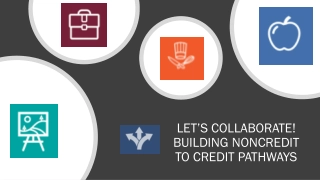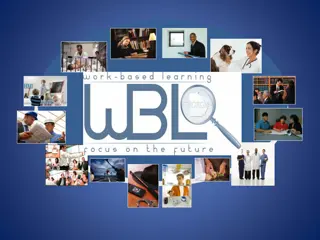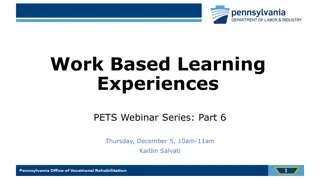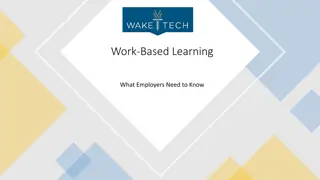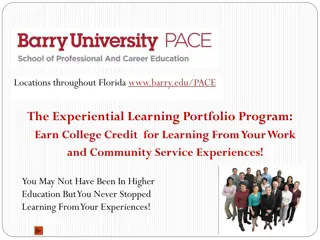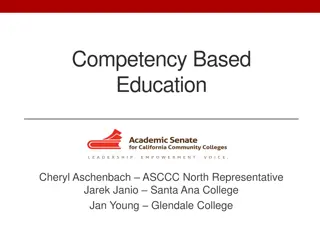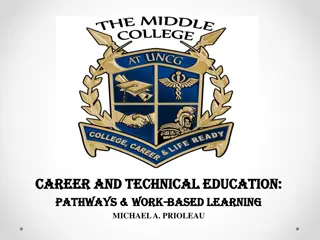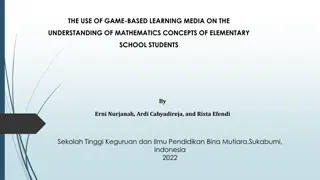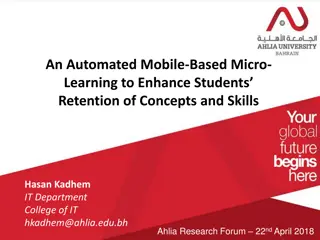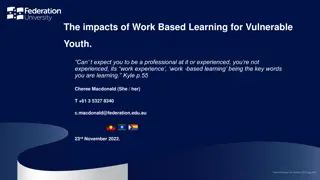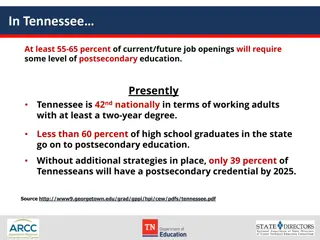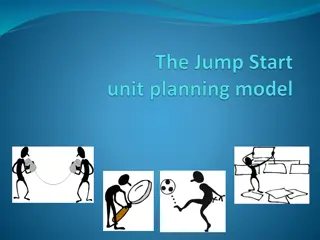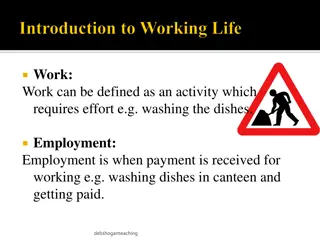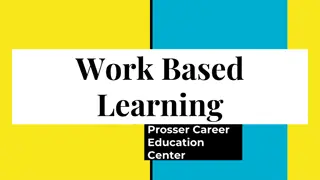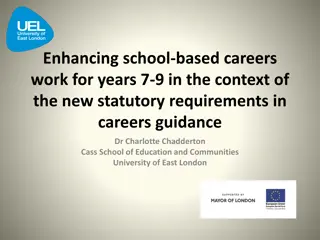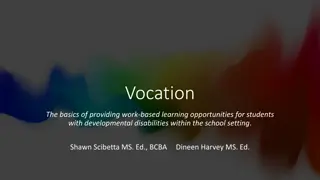Enhancing Work-Based Learning for Noncredit Students
Work-based learning offers valuable experiences for noncredit students by connecting them with real-world career opportunities, improving student engagement, guiding career choices, enhancing employability skills, and boosting completion rates. It benefits students, colleges, and employers in various ways, providing positive relationships, relevant learning experiences, and workforce connections. However, challenges such as eligibility restrictions and meeting specific metrics exist for noncredit programs.
Download Presentation

Please find below an Image/Link to download the presentation.
The content on the website is provided AS IS for your information and personal use only. It may not be sold, licensed, or shared on other websites without obtaining consent from the author. Download presentation by click this link. If you encounter any issues during the download, it is possible that the publisher has removed the file from their server.
E N D
Presentation Transcript
Exploring Work-Based Learning Opportunities Noncredit Students
Work-Based Learning: What is it? Work-based learning encompasses a wide array of learning experiences; exposing students to careers along the continuum of life long learning and skills development through classroom activities, school-wide events, and/or structured opportunities for students to interact with employers or community partners either at school, at a worksite, or virtually.
Work-Based Learning (continued): Why is it important? Student engagement Connection Better informed career choices Employability attitudes, behaviors, and skills Increase completion rates
Benefits to Students: Build positive relationships with business/industry/develop contacts to broaden employment opportunities Discover, explore, and set career interests/goals Awareness of career opportunities and pathways Connect classroom learning to the workplace Build self-confidence and experience success
Benefits to College: Build positive relationships with business/industry and community Make classroom learning more relevant to the workforce Expand curriculum to create more dynamic learning environments Higher student engagement, completion rates, and job placements Develop stronger noncredit to credit pathways, guided pathways, and meet metrics for Strong Workforce, California Adult Ed Programs (CAEP), and Student Success Formula
Benefits to Employers: Develop a better-prepared, motivated pool of qualified applicants and reliable source of skills labor Help design curriculum and educational opportunities that meet business/industry requirements/needs Recruit and screen potential employees Opportunity to evaluate potential employees in work and/or work-related settings, prior to hiring Stronger community connections
Challenges for Noncredit: Not eligible to offer noncredit courses under Title 5 Cooperative Work Experience Business Partnerships Meeting the metrics of job attainment, completions, and pathways
Opportunities for Noncredit: Developing stronger partnerships with their credit partners to provide eligibility for noncredit CTE students and/or Academic Success students to participate in internships Creating Industry Recognized Certification opportunities and tying to noncredit curriculum and programs Provide other types of Work-Based Learning Opportunities Developing stronger partnerships with Career Centers and Employability Skills training
Work-Based Learning Continuum: Industry and Career Awareness Career Exploration Career Preparation Career Training
Industry and Career Awareness: Workplace Tour Guest Speaker Industry Workshops Career Planning Courses Assessments/Online Sites: Career Coach California Chancellor s Office (https://ccc.emsicc.com) Here to Career California Community College Foundation (https://www.heretocareer.org) Careeronestop U.S. Department of Labor/Americanjobcenter Network (https://www.careeronestop.org/Toolkit/toolkit.aspx
Career Exploration: Informational Interviews Job Shadow Field Trips Virtual Exchange with a Partner Career Fair Industry Workshops/Events Trade Shows Department/Program Open House
Career Preparation: Career Centers Career Fairs ePortfolios Employability Skills (New World of Work/LinkedIn Learning) Integrated project with multiple interactions with professionals Technical mentoring through online interactions with partners Projects with partners through industry student organizations Student Competitions Clubs
Career Training: Simulation Labs Student-run enterprise with partner involvement Service learning and social enterprises with partners Externships/Internships Apprenticeship Practicum Clinical experience On-the-job training
Noncredit Statewide Metrics: 2019-2020 Strong Workforce Progress Attained a noncredit workforce milestone* in an academic year Noncredit workforce milestone = completed a noncredit CTE course or had 48 or more contact hours in a noncredit career education course Credential Attainment Earned a CTE Chancellor s Office approved certificate/degree or achieved journey level status Employment Employed in a job closely related to their field of study Earnings Median annual earnings among exiting CTE students; Improved earnings; Attained the county-level living wage
Noncredit Statewide Metrics: (continued) California Adult Education Program (CAEP) Participation Community college noncredit students, who have one or more hours of instructional contact hours in any of the seven program areas and/or receive support services Progress Transition to a new program: From ABE/ESL/ASE to CTE Completion Completion of postsecondary certificates, degrees, or training programs: CDCP CTE certificates 48+ hours) Placement into Jobs Employment after two or four quarters post exit
Noncredit Statewide Metrics: (continued) California Adult Education Program (CAEP) - continued Placement into Jobs Employment after two or four quarters post exit Improved Wages Wage gain four quarters after exit Median wage attainment two quarters after exit Attainment of a living wage Transition to Postsecondary Transition to noncredit or credit CTE program Transition to credit courses that are not developmental
Orange County Regional Projects: LinkedIn Learning Students will create and post a profile Have access to LinkedIn Learning: Community College student training focusing on top 12 competencies needed for employment Have specific video training for students on these competencies Digital badges for completing
Project Pilot 2: Noncredit Curriculum Development and Alignment Curriculum: Uses LinkedIn Learning and New World of Work 21st Century Skills videos and modules Modeled after the Santa Barbara City College Career Skills Institute Certificates Flipped Classroom Model Hybrid classes (do LinkedIn Learning modules, then come into classroom to do capstone projects based on what they are studying)
Project Pilot 2 (Continued): Focus: Career and workforce skills Can be taught at all 10 schools Have similar curriculum throughout region Benefits: Regional courses developed in conjunction with LinkedIn learning and community college faculty Students will earn digital badges and key skills Colleges will be able to offer new CDCP Certificates in Workforce Prep
Project Pilot 3: Regional Career Skills Expo (Career Fair with a twist) Industry Focus Have roundtables of employers from specific industries to meet and talk with students. Talk about skills, hiring practices, etc. Workshop Series for students Resume writing Interviewing techniques New World of Work LinkedIn Resume Critiques and Mock Interviews Professional headshots Staff to help with online applications, LinkedIn accounts, resumes, etc. Networking for faculty and students Workshops or Meet & Greets for Faculty and Employers
Project Pilot 4: Portfolium Provides an academic e-portfolio network and showcase connecting college students and recent graduates with employers Documents students collegiate work, projects and experiences. Links to Canvas students can upload classwork and projects Combines features typically reserved for social and professional networking platforms with the ability to create and aggregate multimedia content from across the web, Portfolium uniquely provides a deeper, all-encompassing view of student s passions, abilities and potential.
Project Pilot 4 (continued): Portfolium Provides higher education partners with private, branded networks to showcase exclusively the work and entries of the institution s students and alumni. Provides yearly data and analytics reports on network activity, engagement and outcomes are provided to the institution Can make network announcements and maintain a digital resume database.
Contact: Raine Hambly rhambly@noce.edu 714.808.4573


